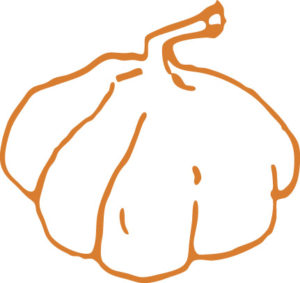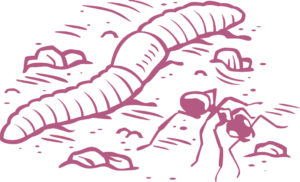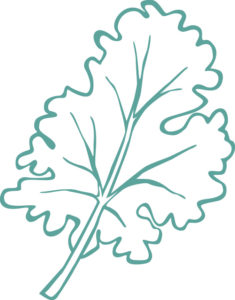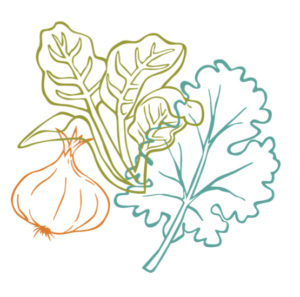Journey through a Winter Garden

Our school gardens are quieter than usual this winter without our students’ daily visits to plant, harvest, and learn. Despite the quiet, amazing natural processes are occurring above and underground in the garden beds, and our FoodPrints teachers are planning their spring gardens, hoping that small groups of students will return soon. As we anxiously await the pitter patter of footsteps back into our gardens, take a moment to join us on a journey through the winter garden.
Garlic Needs the Cold to Grow
 In the fall, single cloves of garlic are planted, and by January, garlic is quite busy beneath the soil. During the cold winter months, that single clove begins to reproduce into many cloves. In spring, green garlic shoots appear, and we are eventually gifted with whole heads of garlic to harvest in the warmer months ahead.
In the fall, single cloves of garlic are planted, and by January, garlic is quite busy beneath the soil. During the cold winter months, that single clove begins to reproduce into many cloves. In spring, green garlic shoots appear, and we are eventually gifted with whole heads of garlic to harvest in the warmer months ahead.
Bugs Burrow into Warm Soil Deep, Down Below
 During wintertime, the top layer of soil in our garden beds is often frozen. Sometimes it’s just a little crust of frozen soil on the top. At other times the freezing layer extends a few inches deep in the soil. But when you dig below these frozen layers, the soil is no longer frozen. Worms, other insects, and small animals escape from the cold upper layers of the soil during the winter months by burrowing into the depths of the soil where it is warm enough for them to stay alive. All of the organic matter below the freezing layers of soil acts like a heated electric blanket for soil dwelling creatures, so they burrow down deeper into the soil to hang out, keep warm, and survive the winter.
During wintertime, the top layer of soil in our garden beds is often frozen. Sometimes it’s just a little crust of frozen soil on the top. At other times the freezing layer extends a few inches deep in the soil. But when you dig below these frozen layers, the soil is no longer frozen. Worms, other insects, and small animals escape from the cold upper layers of the soil during the winter months by burrowing into the depths of the soil where it is warm enough for them to stay alive. All of the organic matter below the freezing layers of soil acts like a heated electric blanket for soil dwelling creatures, so they burrow down deeper into the soil to hang out, keep warm, and survive the winter.
Bacteria & Microorganisms Slow Down
 When temperatures drop, the bacteria, fungi, and microorganisms that keep our garden soil rich and healthy slow down. They are still alive and doing the same work of decomposing and enriching soil that they do every season, but cold temperatures slow the pace of their work.
When temperatures drop, the bacteria, fungi, and microorganisms that keep our garden soil rich and healthy slow down. They are still alive and doing the same work of decomposing and enriching soil that they do every season, but cold temperatures slow the pace of their work.
As humans we sometimes forget to give ourselves the grace to slow down during the winter — to take breaks and store our energy for the months ahead. Perhaps we can learn a lesson from the microorganisms hidden in our soil?
Winter Garden Veggies are a Sweet Treat
 Do you know that vegetables that are able to grow in the winter have less water in them? Tomatoes cannot grow in our winter gardens because they are full of water and freezing temperatures would cause them to burst open and be ruined. But because vegetables like dark green leaves (kale and collards) don’t have much water in them, they are able to survive freezing temperatures. Better yet, these dark leafy green vegetables taste sweeter in the winter because they break their carbohydrates down into simple sugars to help keep their leaves from freezing. This results in very sweet and still very nutritious greens. Yum!
Do you know that vegetables that are able to grow in the winter have less water in them? Tomatoes cannot grow in our winter gardens because they are full of water and freezing temperatures would cause them to burst open and be ruined. But because vegetables like dark green leaves (kale and collards) don’t have much water in them, they are able to survive freezing temperatures. Better yet, these dark leafy green vegetables taste sweeter in the winter because they break their carbohydrates down into simple sugars to help keep their leaves from freezing. This results in very sweet and still very nutritious greens. Yum!
The Gardener Plans for Spring
 During the winter, many gardeners take a rest from the physical labor of planting, harvesting, and maintenance. However, gardeners make full use of the winter months to plan for their spring, summer, and fall gardens. They decide what they want to plant and order seeds, and make plans for the coming year based on successes and failures from the last growing season.
During the winter, many gardeners take a rest from the physical labor of planting, harvesting, and maintenance. However, gardeners make full use of the winter months to plan for their spring, summer, and fall gardens. They decide what they want to plant and order seeds, and make plans for the coming year based on successes and failures from the last growing season.
As FoodPrints teachers, our goal is for students to learn about the natural world, where food comes from, and make connections between their school gardens, the environment, and our food system. Thanks for becoming a FoodPrints student today and joining us on our winter garden journey!


